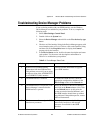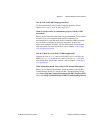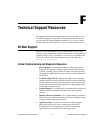Appendix D Windows 98/95: Troubleshooting and Common Questions
© National Instruments Corporation D-7 NI-488.2 User Manual for Windows
Are interrupts and DMA required for the NI-488.2 software?
Neither interrupts nor DMA are required. However, if you are using a GPIB
interface with Analyzer capability (PCMCIA-GPIB+ or AT-GPIB/TNT+),
at least one interrupt level is required for the GPIB Analyzer driver.
In Windows 98/95, you can use your GPIB interface without interrupts, but
the NI-488.2 software performance is significantly slower without
interrupts. For example, transfer sizes between 1 and 10 bytes transfer at a
rate of only 2% of the transfer rate with enabled interrupts. As the transfer
size increases, the performance degradation decreases slightly, but it
remains a significant problem for all transfers under 1 Mbyte. For
instructions on how to assign an interrupt to your GPIB interface if one was
not assigned, refer to the Enabling Interrupts section earlier in this
appendix.
How can I determine if my GPIB hardware and the NI-488.2 software
are installed properly?
Run the NI-488.2 Troubleshooting Wizard. To do so, select Start»
Programs»National Instruments NI-488.2»Explore GPIB. Then, select
Help»Troubleshooting»NI-488.2 Troubleshooting Wizard.
When should I use the Interactive Control utility?
You can use the Interactive Control utility to test and verify instrument
communication, troubleshoot problems, and develop your application.
For more information, refer to Chapter 6, Interactive Control Utility.
How do I use an NI-488.2 language interface?
For information about using NI-488.2 language interfaces, refer to
Chapter 3, Developing Your NI-488.2 Application.
What do I need to know to communicate properly with my GPIB
instrument?
Refer to the documentation that came with your instrument. The command
sequences that you use depend on the specific instrument. The
documentation for each instrument should include the GPIB commands
that you need to communicate with your instrument. In most cases,
device-level traditional NI-488.2 calls are sufficient for communicating
with instruments. For more information, refer to Chapter 3, Developing
Your NI-488.2 Application.


















